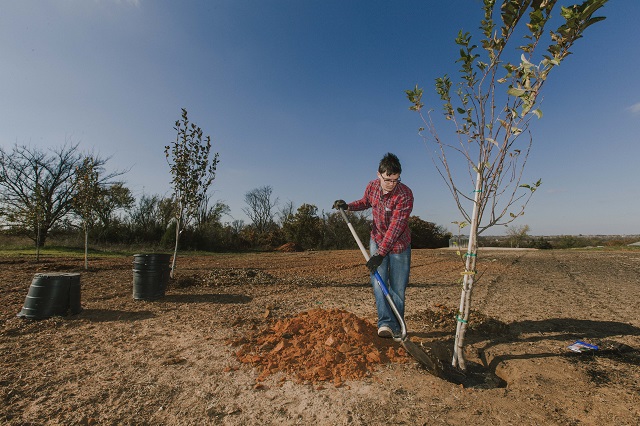
Although January is not the peak time for gardening, it is the perfect time to start planning for the 2017 garden. The CPN Community Garden will be moving to a plot of land behind the Sharp House for the 2017 season.
“One major benefit to the new location is that the community will have more convenient access. This means that they will not be limited to only Tuesday and Thursday volunteer workdays,” Assistant Tribal Historic Preservation Officer Andrew Gourd said. “Also, when the Potawatomi Leadership Program students are living in the Sharp House during the summer, they will have daily access to the garden at a critical time. The goal is to manage to get all of the okra and tomatoes harvested without any loss.”
The main gardening workdays will continue to be Tuesday and Thursday from 3-7 p.m. This is the best time for new volunteers to take a tour and become acquainted with the space and daily chores. After that they will be welcome to check in and work any day of the week.
Along with volunteer workdays, several events are on the calendar for 2017. The main events are community planting around spring break, a community education event and early spring harvest in April, community milkweed planting in May and summer harvest in June. There are plans to have several youth volunteer days and outreach events with St. Gregory’s students.
“Our main goal for the spring is to get acquainted with the new space and learn its personality,” Gourd explained. “It has very different conditions than our previous location. We also hope to have all of our storage and growing buildings erected and in use before our planting day in March.”
Along with the greenhouse and other maintenance buildings that have been moved from the previous location, a hoop house also arrived at the new garden in November. This hoop house was purchased with funds from a U.S. Fish and Wildlife Foundation grant obtained by Monarch Watch, the Euchee Butterfly Farm and seven Native American tribes in Oklahoma.
“We are one of seven tribes participating in monarch habitat restoration in the state,” Gourd said. “We are in a critical zone, essential for the refueling of the insect on their way to Mexico in the fall and for the first generation of monarchs produced in the spring after the butterflies leave Mexico. This hoop house is where we will grow native Oklahoma plant species they use for nectar and laying eggs.”
The cultural heritage center staff seeks to incorporate cultural practices and programming into this new space, including teaching elders and youth how to plant a three sister’s garden.
“Three sisters is the traditional method of growing the food that sustains our people. It involves planting corn, beans and squash in a mound together,” Gourd described. “They each contribute to the success of one another. Corn provides growth for bean vine, bean vine fixes nitrogen in soil for corn and squash, squash shades out weeds and keeps moisture in the soil for all three. All do much better in the presence of one another, as well as provide all the essential nutrients needed for human survival. These plants were a gift given by the Creator to teach that cooperation is essential for survival, but that we all have different roles to play.”
For more information about how to get involved in the CPN Community Garden, please visit the “Gtegemen: CPN Community Garden” Facebook page.
